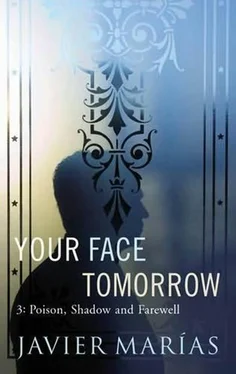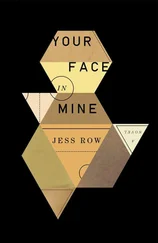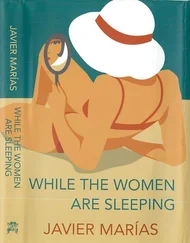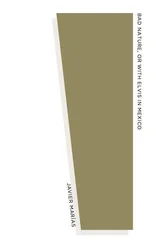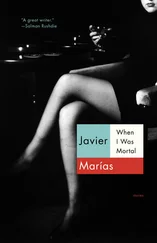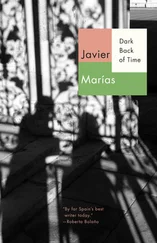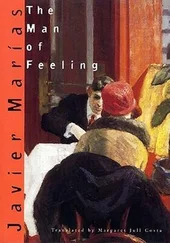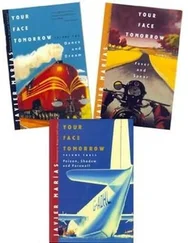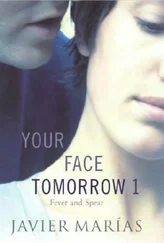'There's Sir Death,' I thought,' as in the English and, generally speaking, the Germanic tradition: he's clearly male, el Muerte not la Muerte, because although he is cadaverous, a semi-skeleton with the skin clinging to bones it barely covers-like a disguise he's adopted to tread the earth, all the more so when you notice his eyes are more deeply sunken than the rest-you can see a few wisps of beard growing out of his chin, and other wisps, resembling tiny tentacles, more like the tentacles of a cuttlefish or a squid than an octopus, peeping out where his penis and his vanished testicles would have been, now there's only a hole where once a codpiece doubtless stood erect. He's certainly not like Sergeant Death in the Armagh ballad ("And when Sergeant Death's cold arms shall embrace me"), who is a man in his prime, a strong energetic warrior prepared to snatch lives away nonstop, an experienced professional with his cold disciplined arms always busy; this Death is the feeblest and most worn of the three figures, or of the four, with his meek broken spear, so meek that an unwary child can almost touch it. And yet there is determination and energy in the scrawny arm that grips, and he is, above all, the master of time, he holds the clock and knows the time and can see when it's running out, the sand or water, whichever it is that his hourglass contains and on which his red-veined eyes are firmly fixed, rather than on the old or the young woman, for time is his only guide, the only thing that counts for this Sir Death, as naked and decrepit as our Latin hag with her scythe, this Sir Death with neither helmet nor sword.' And I suddenly remembered 'the loud tick-tock' in that small sepulchral living room in the Lisbon cemetery of Os Prazeres, which, according to the traveler who 'with a degree of indiscretion' discovered and observed it, 'was to a normal tick-tock what a shout is to the spoken voice'; and I recalled the enigmatic words suggested by the sight of the alarm clock making the noise ('of the kind we used to see in our parents' kitchens, round in shape, with a bell like a spherical skullcap and with two small balls for feet'): 'It seems to me that time is the only dimension in which the living and the dead can talk to each other and communicate, the only dimension they have in common.' Perhaps when all the sand or all the water had trickled through, thus signaling the death of the old woman painted by Baldung Grien, and who was perhaps also the young woman, when he had finally sent them to join 'the more influential and more animated majority,' he would still have to turn over the hourglass or clepsydra in order to begin the countdown again, about which my compatriot the traveler wondered: Was it the amount of time they had been dead or the time yet to elapse before the final judgment? If it was measuring out the hours of solitude, was it counting those that had passed or those still to come?
I kept peering in at the larger Italian gallery, then turning back to spend a little more time with the German painting, which while it no longer frightened me, still intrigued me. From the threshold I saw, too, 'The Annunciation' by Fra Angelico, an excellent full-size copy of which had presided over my father's living room for as long as I could remember, he and my mother had commissioned it from a friend who was a copyist, a Custardoy of the 1930s and '40s, Daniel Canellada was his name I recall; seeing that painting was, for me, like being at home. On one of my brief forays into the German gallery, I lingered too long in front of the Baldung Grien and, when I returned to the Italian gallery, the man was no longer standing before the Parmigianino, I mean, before the Countess and her children. I bounded down the intervening steps, looking anxiously to right and left, but, fortunately, I spotted him at once, his now closed sketchbook under his arm, on his way to the stairs that led up to the first floor and then to the exit. That's when I started to follow him, or where I became more like his shadow, not in quite the same way as I had been with Tupra on the journeys we made together, but in both cases I relegated myself to the background. Once upstairs, he went to the coat check, and I waited with my back turned until he reappeared, looking round every three seconds so as not to lose him again, and when he emerged, I discovered with horror that what he had left there and retrieved was a hat, possibly a fedora ('A man wearing a ponytail and a hat,' I thought, 'possibly a fedora. Good lord!'). He had the good manners not to put it on while he was indoors, but only when he went out into the street, and then I saw-although it brought me little relief-that it was broader brimmed than the aforementioned fedora, more the kind of hat a painter or a conductor or an artist would wear, and black, of course. Duly behatted, he set off down the steps outside the museum, opposite the Hotel Ritz, and I followed after, always at a safe distance. He strode along the Paseo del Prado at a good pace, then stopped outside a brasserie, studied the menu, peered in through the window, shielding his eyes with his hand against the reflections on the glass (wasn't the brim of his presumptuous hat enough?), as if he were considering having lunch there-although it was early for Madrid unless you happened to be a foreigner; perhaps I was wrong, and he was a foreigner; but he didn't look like one to me, I could sense something unequivocally Spanish about his whole appearance, especially the way he walked, or perhaps it was the trousers-and so I took advantage of that pause to look in the window of a nearby shop selling artifacts from Toledo, including swords-obviously aimed at tourists, but nowadays they wouldn't be allowed to take such swords with them on a plane, they'd have to check them, and even then a sword wouldn't easily fit in a suitcase; it wouldn't be permitted on trains either, and I wondered who the devil would buy such swords now if they couldn't be transported anywhere, a collector of decorative knives and swords like Dick Dearlove would presumably have them sent to him some way or other. Most would be made of our famous Toledo steel, very Spanish and very medieval, but I noticed that among those on display there were also a few that were apparently Scottish and even bore the name 'McLeod' engraved on the guard, an ignoble concession to the movie-mad Anglo-Saxon masses. It occurred to me that I might buy one, not right then, of course, but later, for I had learned from Tupra a little of the effect that such an archaic weapon could produce. Almost all of them, however, were much longer and larger, doubtless far more difficult and far heavier to wield than the 'catgutter' or Landsknecht or Katzbalger, they had really huge blades. They would cut off a hand at a blow. They would slice through and dismember. 'No,' I thought, 'it would be best if it were a sword I didn't have to get rid of, one that I could return to its place, used or not, it wouldn't matter, one that I wouldn't have to throw away or deliberately abandon for someone else to find later.'
The man who was now very probably Custardoy continued on along Carrera de San Jeronimo, past my hotel, where he peered in at the entrance and read the plaque there which states, incredibly, that the Palace Hotel was conceived, designed and built in the brief space of fifteen months spanning 1911 and 1912, by the Leon Monnoyer construction company, who were, I suppose, French or Belgian, I don't know how the builders of today-that plague, that horde-can hold up their heads for shame or indeed shamelessness; a little further on, more or less opposite the Parliament building, he paused momentarily by the statue of Cervantes-who also had his sword unsheathed-there were some police vans parked there, with five or six policemen armed with machine guns standing outside to protect the honorable members, even though there were none to be seen, they must all have been inside or off on a trip somewhere or in one of the bars. The man with the ponytail and mustache had clearly retrieved something else from the museum coatcheck, a briefcase with no handles, into which he must have put his sketchbook, and he was carrying said briefcase under his arm and walking quickly, confidently, head up, eyes front, looking frankly about him and at the people he passed, and I had quite a fright when, as he was passing Lhardy, he slowed his pace and turned his head to observe the legs of a girl with whom he had almost collided, possibly deliberately I thought. I was afraid he might see me and recognize me, I mean from before, from the Prado. His response to the young woman was very Spanish, one I often have myself, although whenever I turned round like that in London, I had the sense that I was the only man who did, less so in Madrid, although there are fewer and fewer men who dare to look at whatever we want to, especially when the person we're looking at can't see us and has her back to us, which means that we're not bothering or embarrassing anyone-in these increasingly repressive times the puritans are even trying to control what our eyes do, often quite involuntarily. His was a quick, appreciative, brazen glance, with those large dark marble-like eyes of his, intense and troubling, wide-set and lashless, which more or less coincided with what Cristina had told me about the way he visually grabbed at women; but perhaps that was an exaggeration, I myself sometimes look in a similar way at a passing derriere or a pair of legs as they move off, perhaps with less penetrating appraising eyes, more ironic or more amused. His eyes looked as if they were salivating.
Читать дальше
